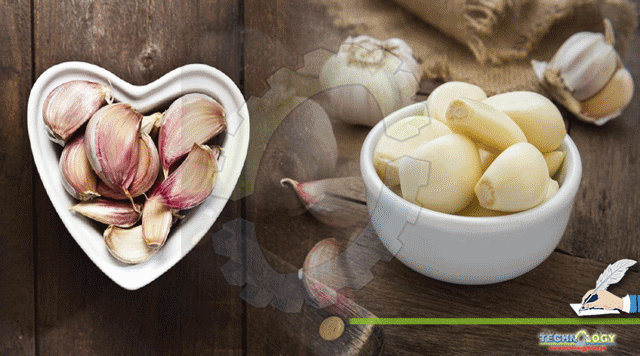Garlic, Allium sativum L. is a member of the Alliaceae family, has been widely recognized as a valuable spice and a popular remedy for various ailments and physiological disorders.

By Aqsa Aslam, Athar Mahmood, Maria Naqve
Introduction
The name garlic may have originated from the Celtic word ‘all’ meaning pungent. Cultivated practically throughout the world, garlic appears to have originated in central Asia and then spread to China, the Near East, and the Mediterranean region before moving west to Central and Southern Europe. Garlic has been used for thousands of years for medicinal purposes. Garlic’s current principal medicinal uses are to prevent and treat cardiovascular disease by lowering blood pressure and cholesterol, as an antimicrobial, and as a preventive agent for cancer. Randomized trials also support garlic’s effectiveness as a mild antihypertensive. Garlic also inhibits platelet aggregation and enhances fibrinolytic activity, reducing clots on damaged endothelium.
CHEMISTRY OF GARLIC
Garlic contains at least 33 sulfur compounds, several enzymes, 17 amino acids, and minerals such as selenium. It contains a higher concentration of sulfur compounds than any other Allium species. The sulfur compounds are responsible both for garlic’s pungent odor and many of its medicinal effects. Dried, powdered garlic contains approximately 1% alliin (S-allyl cysteine sulfoxide). One of the most biologically active compounds, allicin (diallyl thiosulfinate or diallyl disulfide) does not exist in garlic until it is crushed or cut; injury to the garlic bulb activates the enzyme allinase, which metabolizes alliin to allicin. Allicin is further metabolized to vinyl dithiines. This breakdown occurs within hours at room temperature and within minutes during cooking.. Garlic oil, aged garlic and steam-distilled garlic do not contain significant amounts of aliin or allicin, but instead contain various products of allicin transformation.
ROLE OF GARLIC IN VARIOUS DISEASES
Antihypertensive Potential
Garlic (Allium sativum) has played an important dietary as well as medicinal role in human history. Blood pressure reducing properties of garlic have been linked to its hydrogen sulphide production and allicin content – liberated from alliin and the enzyme allinase which has angiotensin II inhibiting and vasodilating effects, as shown in animal and human cell studies.The effect of garlic consumption on blood pressure are not as numerous as the effect of garlic on serum lipids. Again, inconsistent results of the effect of garlic on blood pressure are abounding. Allicin is known to be a systemic vasodilator; moreover it acts as a pulmonary vasodilator in anesthetized intact-chest cat and isolated lung of the rat under constant flow conditions.
Wound Healing Potential
Successful wound healing depends upon angiogenesis, and impaired angiogenesis is a hallmark of the chronic wounds encountered with diabetes and venous or arterial insufficiency. To intervene and improve wound closure, it is essential to investigate the effects of different natural remedies in wound healing. Study was done on the chicken dorsum skin excision wound assay to investigate the influence of different concentrations of aged garlic solution (AGS) on wound healing. Gross, histopathology, scanning electron microscopy (SEM) and computer-based three-dimensional (3D) image-probing techniques were utilized to determine the effects of AGS on wound closure, re-epithelialization, dermal matrix regeneration, and angiogenesis.
Anticancer Potential
A number of studies have demonstrated the chemo preventive activity of garlic by using different garlic preparations including fresh garlic extract, aged garlic, garlic oil and a number of organosulfur compounds derived from garlic. The chemo preventive activity has been attributed to the presence of organosulfur compounds in garlic. The two major compounds in aged garlic, S-allylcysteine and S-allylmercapto-L-cysteine, had the highest radical scavenging activity. In addition, some organosulfur compounds derived from garlic, including S-allylcysteine, have been found to retard the growth of chemically induced and transplantable tumors in several animal models. Therefore, the consumption of garlic may provide some kind of protection from cancer development.
Antidiabetic Potential
Diabetes is a metabolic disturbance that gradually affects the function of various systems in the body. Poorly controlled blood glucose is believed to be the most important factor in the development of diabetic complications in both type 1 and type 2 diabetes. Based on report of WHO, garlic can be used for helping treatment of hyperglycemia. One-third of diabetic patients take alternative medications that they consider efficacious, of which garlic is the most commonly used. Garlic and garlic constituents prepared by various means have been shown to have antidiabetic actions. In diabetic patients, it was reported that garlic oil can correct hyperglycemia.
Immunomodulatory Potential
Allium sativum an important medicinal plant having immune modulatory effects. Three proteins showing immune modulatory were separated from garlic by Q- Sepharose chromatography of 30 kD ultrafiltrate of raw garlic extract. Garlic has been shown to be a possible biological response modifier. First reported the augmentation of tumor immunity by garlic; subsequently a variety of immune stimulatory effects of garlic were reported. Thus, some pharmacologic effects of garlic might be mediated through immune modification. A unique garlic preparation, called aged garlic extract (AGE) has been reported to have an array of pharmacologic effects, including immune modulation.
Authors : Aqsa Aslam, Athar Mahmood, Maria Naqve, University of Agriculture Faisalabad